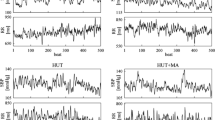Abstract.
The coherence function measures the amount of correlation between two signals x and y as a function of the frequency, independently of their causal relationships. Therefore, the coherence function is not useful in deciding whether an open-loop relationship between x and y is set (x acts on y, but the reverse relationship is prevented) or x and y interact in a closed loop (x affects y, and vice versa). This study proposes a method based on a bivariate autoregressive model to derive the strength of the causal coupling on both arms of a closed loop. The method exploits the definition of causal coherence. After the closed-loop identification of the model coefficients, the causal coherence is calculated by switching off separately the feedback or the feedforward path, thus opening the closed loop and fixing causality. The method was tested in simulations and applied to evaluate the degree of the causal coupling between two variables known to interact in a closed loop mainly at a low frequency (LF, around 0.1 Hz) and at a high frequency (HF, at the respiratory rate): the heart period (RR interval) and systolic arterial pressure (SAP). In dogs at control, the RR interval and the SAP are highly correlated at HF. This coupling occurs in the causal direction from the RR interval to the SAP (the mechanical path), while the coupling on the reverse causal direction (the baroreflex path) is not significant, thus pointing out the importance of the direct effects of respiration on the RR interval. Total baroreceptive denervation, by opening the closed loop at the level of the influences of SAP on RR interval, does not change these results. In elderly healthy men at rest, the RR interval and SAP are highly correlated at the LF and the HF. At the HF, a significant coupling in both causal directions is found, even though closed-loop interactions are detected in few cases. At the LF, the link on the baroreflex pathway is negligible with respect to that on the reverse mechanical one. In heart transplant recipients, in which SAP variations do not cause RR interval changes as a result of the cardiac denervation, the method correctly detects a significant coupling only on the pathway from the RR interval to the SAP.
Similar content being viewed by others
Author information
Authors and Affiliations
Additional information
Received: 28 June 2001 / Accepted in revised form: 23 October 2001
Rights and permissions
About this article
Cite this article
Porta, A., Furlan, R., Rimoldi, O. et al. Quantifying the strength of the linear causal coupling in closed loop interacting cardiovascular variability signals. Biol Cybern 86, 241–251 (2002). https://doi.org/10.1007/s00422-001-0292-z
Issue Date:
DOI: https://doi.org/10.1007/s00422-001-0292-z




